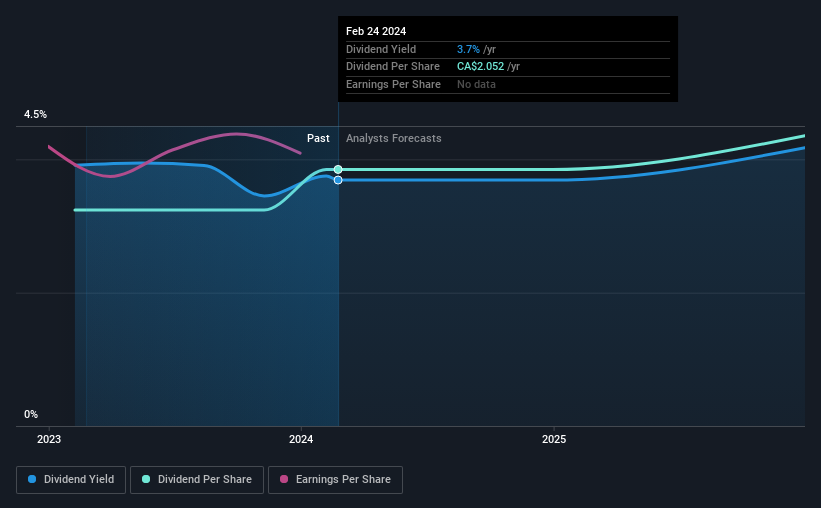Only Three Days Left To Cash In On Brookfield Asset Management's (TSE:BAM) Dividend
Brookfield Asset Management Ltd. (TSE:BAM) stock is about to trade ex-dividend in three days. The ex-dividend date occurs one day before the record date which is the day on which shareholders need to be on the company's books in order to receive a dividend. The ex-dividend date is important as the process of settlement involves two full business days. So if you miss that date, you would not show up on the company's books on the record date. This means that investors who purchase Brookfield Asset Management's shares on or after the 28th of February will not receive the dividend, which will be paid on the 28th of March.
The company's next dividend payment will be US$0.38 per share, and in the last 12 months, the company paid a total of US$1.52 per share. Last year's total dividend payments show that Brookfield Asset Management has a trailing yield of 3.7% on the current share price of CA$55.63. Dividends are an important source of income to many shareholders, but the health of the business is crucial to maintaining those dividends. So we need to investigate whether Brookfield Asset Management can afford its dividend, and if the dividend could grow.
See our latest analysis for Brookfield Asset Management
If a company pays out more in dividends than it earned, then the dividend might become unsustainable - hardly an ideal situation. Fortunately Brookfield Asset Management's payout ratio is modest, at just 27% of profit.
When a company paid out less in dividends than it earned in profit, this generally suggests its dividend is affordable. The lower the % of its profit that it pays out, the greater the margin of safety for the dividend if the business enters a downturn.
Click here to see the company's payout ratio, plus analyst estimates of its future dividends.
Have Earnings And Dividends Been Growing?
When earnings decline, dividend companies become much harder to analyse and own safely. If earnings fall far enough, the company could be forced to cut its dividend. From this perspective it's somewhat discouraging that earnings per share are down 2.5% but we'd note that investment in future growth can cause a similar impact.
We'd also point out that Brookfield Asset Management issued a meaningful number of new shares in the past year. Trying to grow the dividend while issuing large amounts of new shares reminds us of the ancient Greek tale of Sisyphus - perpetually pushing a boulder uphill.
Given that Brookfield Asset Management has only been paying a dividend for a year, there's not much of a past history to draw insight from.
The Bottom Line
From a dividend perspective, should investors buy or avoid Brookfield Asset Management? Brookfield Asset Management's earnings per share are down sharply over the last year, although we note that it is paying out a low fraction of its earnings. Ordinarily we wouldn't be too concerned about a one-year decline, but the -2.5% drop in earnings per share is enough to make us think twice. In sum this is a middling combination, and we find it hard to get excited about the company from a dividend perspective.
If you're not too concerned about Brookfield Asset Management's ability to pay dividends, you should still be mindful of some of the other risks that this business faces. To help with this, we've discovered 2 warning signs for Brookfield Asset Management that you should be aware of before investing in their shares.
A common investing mistake is buying the first interesting stock you see. Here you can find a full list of high-yield dividend stocks.
Have feedback on this article? Concerned about the content? Get in touch with us directly. Alternatively, email editorial-team (at) simplywallst.com.
This article by Simply Wall St is general in nature. We provide commentary based on historical data and analyst forecasts only using an unbiased methodology and our articles are not intended to be financial advice. It does not constitute a recommendation to buy or sell any stock, and does not take account of your objectives, or your financial situation. We aim to bring you long-term focused analysis driven by fundamental data. Note that our analysis may not factor in the latest price-sensitive company announcements or qualitative material. Simply Wall St has no position in any stocks mentioned.

